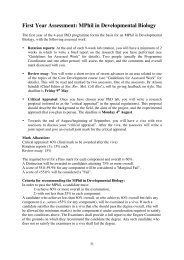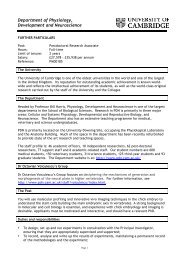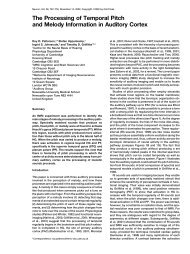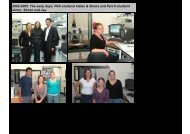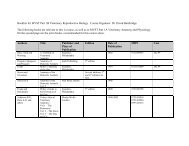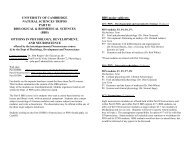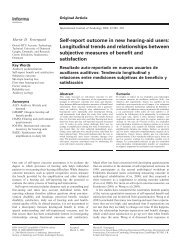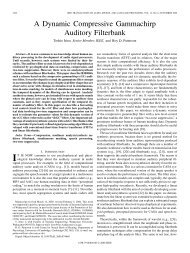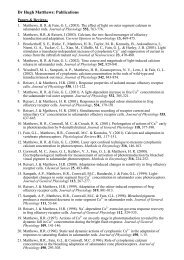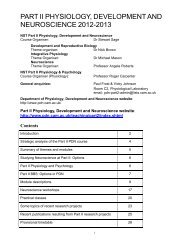FRIDAY MORNING, 20 MAY 2005 REGENCY E, 8:30 A.M. TO 12:00 ...
FRIDAY MORNING, 20 MAY 2005 REGENCY E, 8:30 A.M. TO 12:00 ...
FRIDAY MORNING, 20 MAY 2005 REGENCY E, 8:30 A.M. TO 12:00 ...
Create successful ePaper yourself
Turn your PDF publications into a flip-book with our unique Google optimized e-Paper software.
8:<strong>30</strong><br />
5aPAa3. Investigation of the applicability of microphones to nonlinear<br />
acoustic mine detection. Douglas Fenneman and Brad Libbey U.S.<br />
Army RDECOM CERDEC Night Vision and Electron. Sensors<br />
Directorate, 10221 Burbeck Rd., Fort Belvoir, VA 2<strong>20</strong>60<br />
The feasibility of using microphones to measure intermodulation effects<br />
above a buried mine is under investigation at the U.S. Army RDE-<br />
COM CERDEC Night Vision and Electronic Sensors Directorate. Acoustic<br />
mine detection techniques employ acoustic energy to excite soil and buried<br />
mines. The resultant linear and nonlinear response at the surface can<br />
then be measured using non-contacting vibrometers. Carrier signal scattering<br />
by rough surfaces, however, can limit the measurement accuracy of<br />
these vibrometers and, subsequently, successful detection of the landmine.<br />
A microphone is proposed as an alternative non-contact sensor specifically<br />
for nonlinear acoustic mine detection applications. In this scenario, distinct<br />
frequency content facilitates separation of the intermodulation effects<br />
at the surface from the acoustic excitation. Experimental results employing<br />
intermodulation effects for acoustic mine detection have been reported in<br />
the literature Donskoy et al., J. Acoust. Soc. Am. 111, 2705–2714<br />
<strong>20</strong>02. Preliminary experimental results demonstrate the ability of microphones<br />
to sense pressure radiated from soil in the presence of realistic<br />
ground velocities. The applicability of these measurements to practical<br />
mine detection systems will also be addressed.<br />
8:45<br />
5aPAa4. Application of time-reversal focusing in elastic wave<br />
propagation to buried object detection. Pelham D. Norville and<br />
Waymond R. Scott, Jr. School of Elec. and Comput. Eng., Georgia Inst.<br />
of Technol., 777 Atlantic Dr., Altanta, GA <strong>30</strong>332-0250<br />
Time-reversal focusing is a technique for focusing energy both spatially<br />
and temporally to a single desired point. First studied in fluid media,<br />
additional studies have demonstrated the applicability of time-reversal focusing<br />
to solid media and elastic wave propagation. A significant difference<br />
between time-reversal and other focusing methods is time-reversal<br />
focusings immunity to the variation of wave speeds and the effects of<br />
scattering objects within the medium. In the detection of buried objects,<br />
this feature is paramount where wave speed variations and clutter are<br />
common in the region to be searched. The effectiveness of time-reversal<br />
focusing is investigated for a variety of configurations of scattering objects.<br />
Fields of uniform objects are examined as well as distributions of<br />
randomly shaped clutter, and changes in the propagation medium. Both<br />
experimental and three-dimensional numerical results are presented. In<br />
previous studies, a phenomenon of super-resolution caused by high-order<br />
scattering has been observed where focusing exceeds the diffraction limits<br />
of the excitation array. The extent of super-resolution is evaluated for the<br />
various configurations of scattering objects in an elastic medium. Work<br />
supported by ARO.<br />
9:<strong>00</strong><br />
5aPAa5. Nonlinear acoustic experiments involving landmine<br />
detection: Connections with mesoscopic elasticity and slow dynamics<br />
in geomaterials, Part II. Murray S. Korman Phys. Dept., U.S. Naval<br />
Acad., Annapolis, MD 21402 and James M. Sabatier Univ. of<br />
Mississippi, University, MS 38677<br />
In nonlinear acoustic detection, airborne sound at two primary tones,<br />
f 1 , f 2 chosen several Hz apart from resonance insonifies the soil surface<br />
over a buried landmine, and due to soil wave interactions with the landmine,<br />
a scattered surface profile can be measured by an LDV. Profiles at<br />
f 1 , f 2 , f 1 ( f 2 f 1 ) and f 2 ( f 2 f 1 ) exhibit a single peak while profiles<br />
at 2 f 1 ( f 2 f 1 ), f 1 f 2 and 2 f 2 ( f 2 f 1 ) are attributed to higher order<br />
mode shapes. The lowest resonant frequency for a VS 1.6 plastic, inert,<br />
anti-tank landmine, buried at 3.6 cm deep is <strong>12</strong>5 Hz. The ‘‘on target’’ to<br />
‘‘off target’’ contrast ratio, for some of the nonlinearly generated combination<br />
tones, is roughly 15–<strong>20</strong> dB higher compared to either primary<br />
component. Near resonance, the bending softening of a family of increasing<br />
amplitude tuning curves, involving the surface vibration over the<br />
landmine, exhibits a linear relationship between the peak particle velocity<br />
and corresponding frequency. The tuning curves exhibit hysteresis effects.<br />
Landmine-soil vibrations exhibit similar characteristics to nonlinear<br />
mesoscopic/nanoscale effects that are observed in geomaterials like rocks<br />
or granular materials. Nonlinear mechanisms of soil and the soil interacting<br />
with the top-plate of the mine case are compared. Work supported by<br />
U.S. Army RDECOM CERDEC, NVESD.<br />
9:15<br />
5aPAa6. Time-dependent finite-element model for optimizing source<br />
array element position and excitation for a seismic sonar for buried<br />
mine detection. Anthony N. Johnson CPT, U.S. Army, and Dept. of<br />
Mathematics, Naval Postgrad. School, Monterey, CA 93943, Clyde L.<br />
Scandrett Naval Postgrad. School, Monterey, CA 93943, and Steven R.<br />
Baker Naval Postgrad. School, Monterey, CA 93943<br />
A three-dimensional 3-D continuum mechanics approach to the development<br />
of a time-dependent finite-element model for optimizing the<br />
position and excitation of source array elements for use in a seismic sonar<br />
to detect buried landmines is presented. Mathematical formulation of the<br />
problem consists of the coupling of a system of linear, second order,<br />
partial differential equations and related boundary conditions into one<br />
single wave equation, from which a composite elastic finite element is<br />
derived. The hp-adaptive finite-element kernel, ProPHLEX Altair Engineering,<br />
Inc., McKinney, TX, is used to perform the numerical computations.<br />
The radiation characteristics of a discrete number of transient seismic<br />
sources are analyzed in a linear, isotropic, homogeneous half-space.<br />
Results for radial and vertical radiation fields, and for radiated Rayleigh<br />
wave strength will be presented for various source configurations. Particular<br />
attention will be paid to those configurations which maximize the radiation<br />
of unidirectional Rayleigh waves, while suppressing the radiation<br />
of unwanted body waves.<br />
9:<strong>30</strong><br />
5aPAa7. Deduction of ground impedance using level difference<br />
measurements. Shahram Taherzadeh Faculty of Technol., The Open<br />
Univ., Milton Keynes MK7 6AA, England and Keith Attenborough<br />
Univ. of Hull, Hull HU6 7RX, England<br />
Previously, a numerical method for deducing ground-surface impedance<br />
from measurements of complex excess attenuation spectra was reported<br />
J. Acoust. Soc. Am. 105, <strong>20</strong>39–<strong>20</strong>42 1999. Subsequent applications<br />
have predicted unrealistic values at low frequencies. Here, we<br />
report improved results using two-microphone, transfer-function measurements<br />
and discuss its merits as opposed to measuring excess attenuation in<br />
regards to a free field. Furthermore, effects of errors in measured parameters<br />
on the deduced impedance are discussed also.<br />
9:45<br />
5aPAa8. Comparison of two mapping methods for computing sound<br />
propagation over irregular terrain. Xiao Di Appl. Res. Lab., Penn<br />
State Univ., University Park, PA 16804, xxd1@psu.edu and Kenneth E.<br />
Gilbert Univ. of Mississippi, University, MS 38677<br />
This paper compares a piecewise linear mapping and a cascaded conformal<br />
mapping for computing sound propagation over irregular terrain<br />
using the parabolic equation PE approximation. Although the piecewise<br />
linear mapping does not preserve the form of the underlying Helmholtz<br />
equation i.e., it is not conformal, it does preserve the form of the narrowangle<br />
PE. Further, it is shown that the correct impedance boundary condition<br />
at the ground surface can be closely approximated with the piecewise<br />
linear mapping. Compared to the cascaded conformal mapping, the<br />
piecewise mapping is extremely simple and easy to implement. It involves<br />
only a phase multiplication at the end of each range step. To test the<br />
accuracy of the piecewise linear mapping, it is compared with a cascaded<br />
conformal mapping for propagation over a single hill at various frequencies.<br />
Propagation predictions for more general terrain using the piecewise<br />
linear mapping are presented and discussed. Work supported by the Federal<br />
Aviation Administration.<br />
2594 J. Acoust. Soc. Am., Vol. 117, No. 4, Pt. 2, April <strong>20</strong>05 149th Meeting: Acoustical Society of America 2594



